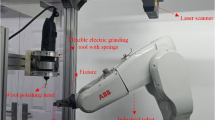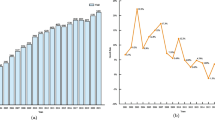Abstract
The nuclear reactor coolant pump (NRCP) is the heart of the nuclear power plant. This paper focuses on robot automation grinding processing for NRCP, which includes scanning, point cloud processing, grinding trajectory generation, and quality evaluation system based on reverse engineering. In this work, firstly, the point cloud of NRCP is obtained by robotic scanner system of hand-eye calibration. Secondly, the research proposes a novel method for point cloud simplification, denoising, and boundary extraction base on k neighborhood octree structure. More important, the efficient trajectory generation of grinding relies on transforming point cloud into adaptive triangular mesh. Lastly, quality evaluation system can calculate the deviation between point cloud and qualified workpiece. And the further path is generated according to the deviation. Experiments show that the accuracy of “246” hand-eye calibration method is less than 0.02 mm. The method of point cloud processing has obvious efficiency advantages over other researchers’ algorithms. The final results indicate that the error of grinding is less than 3 mm and efficiency can be improved by 2.5 times compared with manual grinding.
Similar content being viewed by others
References
Bogue R (2009) Finishing robots: a review of technologies and applications. Ind Robot-an Int J 36(1):6–12
Wang W, Liu F, Liu Z, Yun C (2017) Prediction of depth of cut for robotic belt grinding. Int J Adv Manuf Technol 91:699–708
Lajpah L (2008) Simulation in robotics. Math Comput Simul 79(4):879–897
Takeuchi Y, Ge D, Asakawa N (1993) Automated polishing process with a human-like dexterous robot. IEEE International Conference on Robotics and Automation, 1993. Proceedings (Vol.3, pp.950-956 vol.3). IEEE
Ge DF, Takeuchi Y, Asakawa N (1995) Dexterous polishing of overhanging sculptured surfaces with a 6-axis control robot. IEEE International Conference on Robotics and Automation, 1995. Proceedings (Vol.2, pp.2090-2095 vol.2). IEEE
Tam H, Lui OC, Mok AC (1999) Robotic polishing of free-form surfaces using scanning paths. J Mater Process Technol 95:191–200
Chen S, Wu C, Xue S, Li Z (2018) Fast registration of 3D point clouds with offset surfaces in precision grinding of free-form surfaces. Int J Adv Manuf Technol 97:3595–3606
Berger U, Lepratti R, May M (2005) An approach for the automatic generation of robot paths from CAD-data. IEEE Conference on Emerging Technologies and Factory Automation (Vol.1, pp.7 pp.-297). IEEE
Zuo X, Zhang C, Li H, Wu X, Zhou X (2018) Error analysis and compensation in machining thin-walled workpieces based on the inverse reconstruction model. Int J Adv Manuf Technol 95:2369–2377
Kharidege A, Ting DT, Yajun Z (2017) A practical approach for automated polishing system of free-form surface path generation based on industrial arm robot. Int J Adv Manuf Technol 93:3921–3934
Wang W, Yun C (2011) A path planning method for robotic belt surface grinding. Chin J Aeronaut 24(4):520–526
Lee KH, Woo H, Suk T (2001) Data reduction methods for reverse engineering. Int J Adv Manuf Technol 17(10):735–743
Song Y, Liang W, Yang Y (2012) A method for grinding removal control of a robot belt grinding system. J Intell Manuf 23(5):1903–1913
Xiao G, Huang Y, Yin J (2017) An integrated polishing method for compressor blade surfaces. Int J Adv Manuf Technol 88:1723–1733
Sun Y, Sun S, Xu J, Guo D (2017) A unified method of generating tool path based on multiple vector fields for CNC machining of compound NURBS surfaces. Comput Aided Des 91:14–26
Zhang Z, Feng Y, Ren B, Hagiwara I (2016) Exploratory study of spiral NC tool path generation on triangular mesh based on local subdivision. Int J Adv Manuf Technol 83(5–8):835–845
Liu Z, Li X, Song Y, Yi B (2017) Generating spiral tool paths based on spiral enter assistant line. Int J Adv Manuf Technol 92:869–879
Sun W, Bradley C, Zhang Y, Loh HT (2001) Cloud data modelling employing a unified, non-redundant triangular mesh. Comput Aided Des 33(2):183–193
Lee KH, Woo H, Suk T (2001) Point data reduction using 3D grids. Int J Adv Manuf Technol 18(3):201–210
Lan J, Li J, Li J, Zheng L, Hu G, He G (2013) Data reduction based on dynamic-threshold uniform grid-algorithm. Optik 124(23):6461–6468
Shi B, Liang J, Liu Q (2011) Adaptive simplification of point cloud using k-means clustering. Comput Aided Des 43(8):910–922
Han H, Han X, Sun F, Huang C (2015) Point cloud simplification with preserved edge based on normal vector. Optik 126(19):2157–2162
Su T, Wang W, Lv Z, Wu W, Li X (2016) Rapid Delaunay triangulation for randomly distributed point cloud data using adaptive Hilbert curve. Comput Graph 54:65–74
Yuwen S, Xiaoming W, Dongming G, Jian L (2009) Machining localization and quality evaluation of parts with sculptured surfaces using SQP method. Int J Adv Manuf Technol 42(11):1131–1139
Funding
The authors are grateful for the support provided by National Natural Science Foundation of China (grant # 51775542) and National Natural Science Foundation of China (grants # 51605475).
Author information
Authors and Affiliations
Corresponding author
Rights and permissions
About this article
Cite this article
Zhang, H., Li, L. & Zhao, J. Robot automation grinding process for nuclear reactor coolant pump based on reverse engineering. Int J Adv Manuf Technol 102, 879–891 (2019). https://doi.org/10.1007/s00170-018-03230-8
Received:
Accepted:
Published:
Issue Date:
DOI: https://doi.org/10.1007/s00170-018-03230-8




